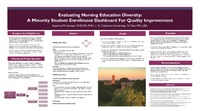| dc.contributor.author | Beltz, Suzanne | en |
| dc.contributor.author | Goodman, Nancy | en |
| dc.date.accessioned | 2012-09-12T09:22:39Z | |
| dc.date.available | 2012-09-12T09:22:39Z | |
| dc.date.created | Thursday, August 2, 2012 | en |
| dc.date.issued | 2012-9-12 | |
| dc.identifier.uri | http://hdl.handle.net/10755/243466 | |
| dc.description.abstract | Hispanics are the largest and fastest-growing minority population in the United States. Of the registered nurses in the United Stated only 3.8% are Hispanic. The percentage of Hispanic nurses educated at the baccalaureate level or higher is even smaller. The Texas A&M University-Corpus Christi mission includes serving and educating the people of South Texas where the population is over 85% Hispanic. Over time, working with students who were struggling in the nursing program, it appeared that stereotypical evaluations of these struggles did not explain the barriers being shared by students. Purpose: The purpose of this naturalistic study was to examine and understand student experiences perceived as barriers to completing a baccalaureate nursing program. Denzin's Interpretive Interactionism was the framework for this study. This design is appropriate to examine the relationship between persons' personal troubles and the public systems in place to address personal problems. Methods: After IRB approval, students in two courses were recruited to participate in the study. The study was explained to the students. Students were asked to view a 12 minute, 14 second, YouTube video, "Breaking the Barriers" (produced by the California Institute for Nursing and Health Care). Students wrote a reflective essay describing barriers experienced while progressed through the nursing program. No identifying information was included on the essay. Essays were copied into a uniform format by the principle investigator, who did not know any of the students. The written data were then reviewed and analyzed for recurrent themes. Results: Themes will be presented. The most surprising finding was that students reported feeling very alone, not realizing that others had similar experiences. Conclusion: Faculty need to become aware of the possible barriers for student progression beyond study and testing problems. Understanding symptoms of problems can lead to constructive interventions to promote progression to graduation. | en |
| dc.format | Text-based Document | en |
| dc.language.iso | en | en |
| dc.subject | Barriers | en |
| dc.subject | BSN Program | en |
| dc.subject | minority students | en |
| dc.title | Understanding Barriers to Completing a BSN Program: A Focus on Hispanic Students | en |
| dc.type | Presentation | en |
| dc.rights.holder | <p>
All rights reserved by the author(s) and/or publisher(s) listed in this item record unless relinquished in whole or part by a rights notation or a Creative Commons License present in this item record.
</p><p>
All permission requests should be directed accordingly and not to the Sigma Repository.
</p><p>
All submitting authors or publishers have affirmed that when using material in their work where they do not own copyright, they have obtained permission of the copyright holder prior to submission and the rights holder has been acknowledged as necessary.
</p> | |
| dc.description.note | Items submitted to a conference/event were evaluated/peer-reviewed at the time of abstract submission to the event. No other peer-review was provided prior to submission to the Henderson Repository. | |
| dc.type.category | Full-text | en |
| dc.contributor.department | Eta Omicron | en |
| dc.author.details | Beltz, Suzanne, PhD, RN, GCNS-BC; Goodman, Nancy, MSN, BSN, RN | en |
| dc.conference.name | 23rd International Nursing Research Congress | en |
| dc.conference.host | Sigma Theta Tau International, the Honor Society of Nursing | en |
| dc.conference.location | Brisbane, Australia | en |
| dc.date.conferenceyear | 2012 | en_US |
| dc.description.reviewtype | Abstract Review Only: Reviewed by Event Host | en |
| dc.description.acquisition | Proxy-submission | en |





